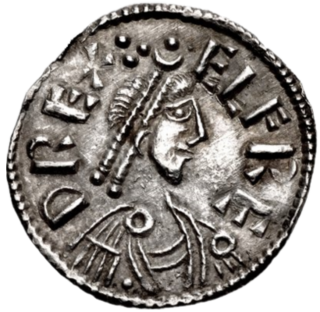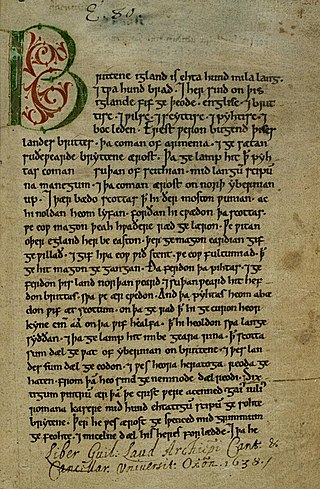Related Research Articles

Alfred the Great was King of the West Saxons from 871 to 886, and King of the Anglo-Saxons from 886 until his death in 899. He was the youngest son of King Æthelwulf and his first wife Osburh, who both died when Alfred was young. Three of Alfred's brothers, Æthelbald, Æthelberht and Æthelred, reigned in turn before him. Under Alfred's rule, considerable administrative and military reforms were introduced, prompting lasting change in England.
Old English literature refers to poetry and prose written in Old English in early medieval England, from the 7th century to the decades after the Norman Conquest of 1066, a period often termed Anglo-Saxon England. The 7th-century work Cædmon's Hymn is often considered as the oldest surviving poem in English, as it appears in an 8th-century copy of Bede's text, the Ecclesiastical History of the English People. Poetry written in the mid 12th century represents some of the latest post-Norman examples of Old English. Adherence to the grammatical rules of Old English is largely inconsistent in 12th-century work, and by the 13th century the grammar and syntax of Old English had almost completely deteriorated, giving way to the much larger Middle English corpus of literature.

Eadred was King of the English from 26 May 946 until his death. He was the younger son of Edward the Elder and his third wife Eadgifu, and a grandson of Alfred the Great. His elder brother, Edmund, was killed trying to protect his seneschal from an attack by a violent thief. Edmund's two sons, Eadwig and Edgar, were then young children, so Eadred became king. He suffered from ill health in the last years of his life and he died at the age of a little over thirty, having never married. He was succeeded successively by his nephews, Eadwig and Edgar.

Æthelstan or Athelstan was King of the Anglo-Saxons from 924 to 927 and King of the English from 927 to his death in 939. He was the son of King Edward the Elder and his first wife, Ecgwynn. Modern historians regard him as the first King of England and one of the "greatest Anglo-Saxon kings". He never married and had no children; he was succeeded by his half-brother, Edmund I.
Asser was a Welsh monk from St David's, Dyfed, who became Bishop of Sherborne in the 890s. About 885 he was asked by Alfred the Great to leave St David's and join the circle of learned men whom Alfred was recruiting for his court. After spending a year at Caerwent because of illness, Asser accepted.
Æthelweard was an ealdorman and the author of a Latin version of the Anglo-Saxon Chronicle known as the Chronicon Æthelweardi. He was a kinsman of the royal family, being a descendant of the Anglo-Saxon King Æthelred I of Wessex, the elder brother of Alfred the Great.

Amlaíb mac Sitric, commonly called Amlaíb Cuarán, was a 10th-century Norse-Gael who was King of Northumbria and Dublin. His byname, cuarán, is usually translated as "sandal". His name appears in a variety of anglicized forms, including Olaf Cuaran, Anlaf Sihtricson and Olaf Sihtricson, particularly in relation to his short-lived rule in York. He was the last of the Uí Ímair to play a major part in the politics of the British Isles.

In prosody, alliterative verse is a form of verse that uses alliteration as the principal device to indicate the underlying metrical structure, as opposed to other devices such as rhyme. The most commonly studied traditions of alliterative verse are those found in the oldest literature of the Germanic languages, where scholars use the term 'alliterative poetry' rather broadly to indicate a tradition which not only shares alliteration as its primary ornament but also certain metrical characteristics. The Old English epic Beowulf, as well as most other Old English poetry, the Old High German Muspilli, the Old Saxon Heliand, the Old Norse Poetic Edda, and many Middle English poems such as Piers Plowman, Sir Gawain and the Green Knight, Layamon's Brut and the Alliterative Morte Arthur all use alliterative verse.

The Exeter Book, also known as the Codex Exoniensis or Exeter Cathedral Library MS 3501, is a large codex of Old English poetry, believed to have been produced in the late tenth century AD. It is one of the four major manuscripts of Old English poetry, along with the Vercelli Book in Vercelli, Italy, the Nowell Codex in the British Library, and the Junius manuscript in the Bodleian Library in Oxford. The book was donated to what is now the Exeter Cathedral library by Leofric, the first bishop of Exeter, in 1072. It is believed originally to have contained 130 or 131 leaves, of which the first 7 or 8 have been replaced with other leaves; the original first 8 leaves are lost. The Exeter Book is the largest and perhaps oldest known manuscript of Old English literature, containing about a sixth of the Old English poetry that has survived.
The Seafarer is an Old English poem giving a first-person account of a man alone on the sea. The poem consists of 124 lines, followed by the single word "Amen". It is recorded only at folios 81 verso – 83 recto of the tenth-century Exeter Book, one of the four surviving manuscripts of Old English poetry. It has most often, though not always, been categorised as an elegy, a poetic genre commonly assigned to a particular group of Old English poems that reflect on spiritual and earthly melancholy.
Rune poems are poems that list the letters of runic alphabets while providing an explanatory poetic stanza for each letter. Four different poems from before the mid 20th century have been preserved: the Anglo-Saxon Rune Poem, the Norwegian Rune Poem, the Icelandic Rune Poem and the Swedish Rune Poem.
Layamon's Brut, also known as The Chronicle of Britain, is a Middle English alliterative verse poem compiled and recast by the English priest Layamon. Layamon's Brut is 16,096 lines long and narrates a fictionalized version of the history of Britain up to the Early Middle Ages. It is the first work of history written in English since the Anglo-Saxon Chronicle. Named for Britain's mythical founder, Brutus of Troy, the poem is largely based on the Anglo-Norman French Roman de Brut by Wace, which is in turn a version of Geoffrey of Monmouth's Latin Historia Regum Britanniae. Layamon's poem, however, is longer than both and includes an enlarged section on the life and exploits of King Arthur. It is written in the alliterative verse style commonly used in Middle English poetry by rhyming chroniclers, the two halves of the alliterative lines being often linked by rhyme as well as by alliteration.
Guthrum II was, according to some reconstructions, a King of East Anglia in the early tenth century. He should not be confused with the earlier and better-known Guthrum, who fought against Alfred the Great.
"Maxims I" and "Maxims II" are pieces of Old English gnomic poetry. The poem "Maxims I" can be found in the Exeter Book and "Maxims II" is located in a lesser known manuscript, London, British Library, Cotton Tiberius B i. "Maxims I" and "Maxims II" are classified as wisdom poetry, being both influenced by wisdom literature, such as the Havamal of ancient Germanic literature. Although they are separate poems of diverse contents, they have been given a shared name because the themes throughout each of the poems are similar.

The Anglo-Saxon Chronicle is a collection of annals in Old English, chronicling the history of the Anglo-Saxons.
The Durham Proverbs is a collection of 46 mediaeval proverbs from various sources. They were written down as a collection, in the eleventh century, on some pages of a manuscript that were originally left blank. The manuscript is currently in the collection of Durham Cathedral, to which it was donated in the eighteenth century. The Proverbs form the first part of the manuscript. The second part, to which it is bound, is a copy of Ælfric's Grammar. Each proverb is written in both Latin and Old English, with the former preceding the latter. Olof Arngart's opinion is that the Proverbs were originally in Old English and translated to Latin, but this has since been disputed in a conference paper by T. A. Shippey.

Anglo-Saxon riddles are a significant genre of Anglo-Saxon literature. The riddle was a major, prestigious literary form in early medieval England, and riddles were written both in Latin and Old English verse. The pre-eminent composer of Latin riddles in early medieval England was Aldhelm, while the Old English verse riddles found in the tenth-century Exeter Book include some of the most famous Old English poems.
Durham, also known as De situ Dunelmi, Carmen de situ Dunelmi or De situ Dunelmi et de sanctorum reliquiis quae ibidem continentur carmen compositum, is an anonymous late Old English short poem about the English city of Durham and its relics, which might commemorate the translation of Cuthbert's relics to Durham Cathedral in 1104. Known from the late 12th-century manuscript, Cambridge, University Library, Ff. 1. 27, Durham has been described both as "the last extant poem written in traditional alliterative Old English metrical verse" and as being placed "so conveniently on the customary divide between Old and Middle English that the line can be drawn right down the middle of the poem." Scholars have dated the poem either to the twelfth century or to some point in the second half of the eleventh century.
The Old English Boethius is an Old English translation/adaptation of the sixth-century Consolation of Philosophy by Boethius, dating from between c. 880 and 950. Boethius's work is prosimetrical, alternating between prose and verse, and one of the two surviving manuscripts of the Old English translation renders the poems as Old English alliterative verse: these verse translations are known as the Metres of Boethius.
References
- ↑ Keynes and Lapidge, Alfred the Great. p. 47.
- ↑ Baugh, Malone, The Literary History of England: Vol 1: The Middle Ages (to 1500), p. 154.
- ↑ Deskis, Susan E. (2017). "Proverbs of Alfred". Wiley Online Library - Proverbs of Alfred - Abstract. John Wiley & Sons. pp. 1–2. doi:10.1002/9781118396957.wbemlb026. ISBN 9781118396957.
- ↑ Rouse, The Idea of Anglo-Saxon England, pp. 38-39.
- 1 2 Rouse, The Idea of Anglo-Saxon England, p. 13.
- ↑ Christopher Cannon, 'Proverbs and the Wisdom of Literature: The Proverbs of Alfred and Chaucer’s Tale of Melibee’, Textual Practice, 24.3 (2010), 407–34 (pp, 413-14) doi : 10.1080/09502360903471862.
Sources
- Keynes, Simon, and Lapidge, Michael, Alfred the Great: Asser's Life of King Alfred & Other Contemporary Sources. Penguin Classics, 1984. ISBN 978-0-14-044409-4